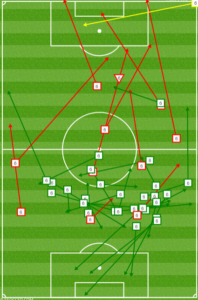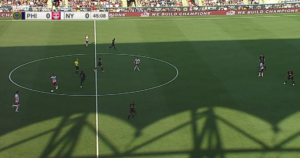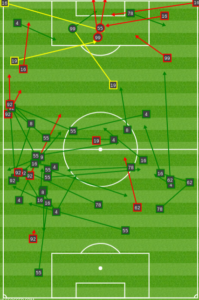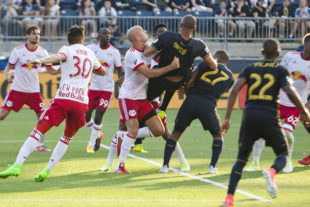Photo: 215pix
The offseason question was how to exert more control over games. The answer was a Bosnian with an elite left foot and a captain’s mentality.
The in-season question, then, was always clear: What happens when the opposition can take away Haris Medunjanin’s time and space?
On Sunday, the answer was… a lot of nothing.
Medunjanin, far less than fresh following 90 midweek minutes against Harrisburg City, was harried for 90 minutes by New York Red Bulls’ full field pressure. In the first half, the Union’s most creative passer, and the base around which their attack is built, attempted one pass in the attacking half. Even more distressing, he only attempted two passes into the attacking half — both incomplete.

Medunjanin passing chart
His only long completions were the five passes he sent back to Andre Blake.
A hard fight, but not a smart one
On a day so humid that Allen Chapman paused the match for a hydration break, conserving energy was always going to be key. Yet Philly was never able to establish a buildup game and relied heavily on quick, direct counterattacks. As the Union sought to create space in their offense by dropping the center backs deep and stretching the fullbacks to the sidelines, the visitors responded by daring Philly to find Ilsinho without the use of Medunjanin, who was heavily pressed no matter how far he dropped to receive the ball.
This was a good plan, made better by Philly’s response to it. The Union’s wingers are not great in the buildup phase, and while Fabinho’s ability to dribble out of pressure is helpful (if dangerous), neither fullback is a very creative passer. These issues combined to create an extremely vertical, energy-heavy attack that was exacerbated by Ilsinho’s belief that he can fit passes into windows the size of submarine portholes.
Even without Derrick Jones’ red card, the Union were in trouble.
Attacking width
Sunday’s match highlighted a persistent — and persistently strange — issue in Philly’s attack. The success Fafa Picault has had in a free roaming role up front has papered over the lack of cohesion between the speedy winger and Fabinho. The Union’s Brazilian left back is known for getting forward in attack (and for crossing the ball once he’s up there), but numerous times on Sunday, he was far too deep when Picault drifted central, leaving the left side naked and preventing Philly from using width to escape pressure.
In the first half, inability to spread the field in attack was noticeable but hardly a fatal flaw. The Union attacked Aaron Long on the opposite flank with success, and both Pontius and Picault had the legs to get forward and recover.
This couldn’t last, and Jones’ dismissal lent cover to the Union as New York blossomed, Kemar Lawrence solving their first half issues on the left and the disconnect between Picault and Fabinho leaving the right side a wasteland.
Ilsinho is out right now, please leave a message
For all the positives and negatives Ilsinho brings to a match, there is one that makes it inevitable Philly will eventually move away from him as a 10: He cannot control a game.
Influence? Sure, on occasion. But control? Nah, it’s just not him.
Controlling a match means forcing a game to be played the way that suits you. Think about Haris Medunjanin moving into holes, playing short passes and then launching a corner pass that puts Philly into the final third. Think about Vincent Nogueira drawing an entire midfield to one side of the pitch with tiny combinations, then pivoting and switching fields. Think, even, of Sebastien Le Toux’s early days, when center backs ran marathons chasing a striker who could drag them out to the corner flags chasing ostensible lost causes.
Ilsinho’s unpredictability can be both a blessing and a curse; he is unpredictable to a defense at times, but it’s also hard to figure out what his larger strategy is at the attacking midfield position. Numerous times on Sunday, he found the ball in space and attempted to thread a needle when a large hole was moments away from presenting itself.
Perhaps the most memorable moment was in the 43rd minute, when he tried an audacious cutback throughball into traffic as the defense collapsed centrally on a transition. Simply taking a touch would have given CJ Sapong the chance to roll into the right channel alone, but Ilsinho was already locked in. This mistake was compounded by a half-hearted defensive effort that opened space for Red Bulls to counter quickly.

Union center backs disconnected from, well, everyone.
The backs are too far back
Unpredictability is also a trait Bradley Wright-Phillips has in spades. Though the striker lacks the tricky feet of Ilsinho, his movement off the ball is so varied that it forces center back pairings to remain central together to defend him.
Both timing and angles are key to a striker’s movement, and Wright-Phillips likes to peel away from the ball after a turnover, moving across the eyeline of both center backs. These post-turnover moments are the most chaotic in a match, and for center backs they are the most vulnerable moments. A read must include: How is the defense reacting around me? Do I need to step up? Is there a runner coming through off the ball? And, finally: Where is that pesky striker?
A huge motivator behind the rise of high pressure systems is that they allow the defense to play on the front foot during those wild moments. If the aim is to get men around the ball, the defense should be stepping forward to close space, forcing a striker to either retreat or remain offside (Dax McCarty is a master of countering high pressing triggers by playing a quick throughball off a dropback pass, knowing that teams like to press on a pass back so he can catch them moving one way while the ball is going another).
BWP hypnotized Philly’s center backs with his movements, resulting in embarrassing moments in which Jack Elliot and Oguchi Onyewu found themselves10-15 yards behind the rest of the team, double-marking a single striker.
Jones can be more
Leaving the red card aside, Derrick Jones had a poor match. Not that his positioning was particularly bad, though it was often questionable. Not that his passing was worse than the rest of the team; it wasn’t. The simple truth is that Jones played like a holding midfielder when he had to be much more.
When the US Men’s U-20 World Cup squad lost to Venezuela, both Jones and New York’s Tyler Adams were far from their best. Jones was outnumbered as Venezuela entered the final third and struggled to read the match quickly enough to push attacks wide. He played reactive and was often overrun. Adams, in contrast, tried to do too much. With his Rolls Royce engine and innate desire to lead, Adams was all over the pitch, creating as many gaps as he closed. Neither player was poor, but they both have the potential to control a match against peers and did not.
Fast forward to Sunday and the hype behind Adams became as clear as the questions about Jones. Adams’ mistakes are quickly forgotten, and he is unwilling to play on anything but the front foot. Meanwhile, Jones can become conservative following mistakes, and never recognized that New York’s system was most likely to be broken by better linking through midfield.
Particularly when New York dropped Sacha Kljestan deeper following the opening half hour, there was an opportunity for Jones to use his extremely unique blend of size and dribbling to break through the middle. Unfortunately, he never put himself in positions to be that needle player, and with Ilsinho increasingly caught out of position, the Union were well on their way to conceding the center when DJ’s red card arrived.

NY passing 45-55 (second half, prior to red card)
There were chances
In a match that featured Medunjanin on half a tank, Chris Pontius without finishing boots (or forehead), and curiously inconsistent hold-up play from CJ Sapong, the biggest issue going forward is this: The Red Bulls offense was not very good. With Kljestan in the hole or deep, and no matter the wingers, New York’s offensive spacing and movement are way out of sync. They sent Tyler Adams extremely deep to pick up the ball from the center backs, and were entirely ineffectual going forward until Kemar Lawrence provided width up the left.
Will that continue all season?
Probably not. There are just too many proven weapons in Jesse Marsch’s arsenal to believe New York will remain only a passing acquaintaince to away goals for the rest of the season. Furthermore, at some point Marsch may put his ego aside and understand that taking a system to its extreme is a good way to strangle its functionality. Unless the perfect combination of players is on the pitch, it’s just extremely hard to execute something as unrelentingly vertical as what the Red Bulls tried to do with a 4-2-2-2 and what they are trying to do now.
Coaches can get caught up trying to execute a plan exactly the way it looks on paper, when the real skill as a coach is crafting players that can creatively solve the unexpected problems they encounter in the course of a game.
New York is going to be good this year. They may not be as good as in the past, but they will be a playoff team.
The Union, on the other hand, have far more uncertainty. After two straight late losses in MLS play, Jim Curtin and his men need to reassess how they try to control matches. Because giving up control late — ten men or eleven — is no way to make the playoffs.


Excellent analysis; well done!
Adam – Any idea on why Marsch started Long at leaft back? Was it purely to try and prevent Pontius’s knockdown headers which seem to be key in the Union’s attack?
My guess – both the aerial presence and the fact that it worked well midweek against NYC. Plus I think Marsch just really likes Long.
Watching from home the commentators noted that Lawrence removed himself from the starting lineup before the game because he wasn’t feeling well. At least that’s what I think I remember.
I’m curious to hear you expound on what you think about the center back pairing from Saturday. It looked like they put in a pretty good shift until the 85th minute, clearing the box at every turn and controlling the ball reasonably well, considering their limited outlet options. On the other hand, your analysis is key in pointing out that they were disconnected from their midfield most of the game. Good game, bad game?